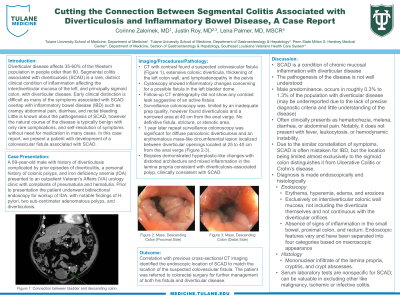Sunday Poster Session
Category: Colon
P0280 - Cutting the Connection Between Segmental Colitis Associated With Diverticulosis and Inflammatory Bowel Disease: A Case Report
Sunday, October 27, 2024
3:30 PM - 7:00 PM ET
Location: Exhibit Hall E

- CZ
Corinne Zalomek, MD
Tulane School of Medicine
New Orleans, LA
Presenting Author(s)
Corinne Zalomek, MD1, Justin B. Roy, MD1, Lena Palmer, MD, MSCR2
1Tulane School of Medicine, New Orleans, LA; 2Southeast Louisiana Veterans Health Care System, New Orleans, LA
Introduction: Segmental colitis associated with diverticulosis (SCAD) is a rare, distinct condition of inflammation affecting interdiverticular colonic mucosa. It is typically benign and self-resolves, with rare complications. This is a case about development of a colovesicular fistula associated with SCAD.
Case Description/Methods: A 69-year-old male with diverticulosis, colonic polyps, and iron deficiency anemia presented to a urology clinic for pneumaturia and hematuria. Prior to presentation, the patient underwent bidirectional endoscopy, notable for H. pylori, two sub-centimeter adenomatous polyps, and diverticulosis.
CT found a suspected colovesicular fistula and extensive colonic diverticula. Cystoscopy showed inflammatory changes concerning for fistula in the left bladder dome; CT enterography did not show any contrast leak suggestive of an active fistula. Colonoscopy limited by inadequate prep found diverticulosis and a narrowed area 40 cm from the anal verge. Repeated colonoscopy had pancolonic diverticulosis and an erythematous mass-like circumferential lesion between diverticular openings at 25 to 40 cm from the anal verge. Biopsies showed hyperplastic changes with distorted architecture and mixed inflammation in the lamina propria consistent with diverticulosis-associated polyp. Correlation with CT identified the endoscopic location of SCAD to match that of the suspected colovesicular fistula. The patient was referred to surgery for further management of both the fistula and diverticular disease.
Discussion: SCAD is a condition of chronic mucosal inflammation with diverticular disease involving the descending and sigmoid colon, sparing the proximal and rectal colon. It affects roughly 0.3% to 1.3% of the population with known diverticular disease, however the pathogenesis is not well understood.
It often presents as hematochezia, melena, diarrhea, or abdominal pain. The diagnosis is made endoscopically and histologically. Histology shows mononuclear infiltrate of the lamina propria, cryptitis, and crypt abscesses. Endoscopic features include erythema, hyperemia, edema, and erosions exclusively on interdiverticular colonic wall mucosa, not in diverticula themselves and not continuous with diverticular orifices.
SCAD is often mistaken for IBD, distinguished by its limited location, lack of fever, leukocytosis, or hemodynamic instability. While very unusual, sequelae are possible. It is essential to recognize SCAD and its atypical complications to differentiate from IBD or other colonic diseases.
Disclosures:
Corinne Zalomek, MD1, Justin B. Roy, MD1, Lena Palmer, MD, MSCR2. P0280 - Cutting the Connection Between Segmental Colitis Associated With Diverticulosis and Inflammatory Bowel Disease: A Case Report, ACG 2024 Annual Scientific Meeting Abstracts. Philadelphia, PA: American College of Gastroenterology.
1Tulane School of Medicine, New Orleans, LA; 2Southeast Louisiana Veterans Health Care System, New Orleans, LA
Introduction: Segmental colitis associated with diverticulosis (SCAD) is a rare, distinct condition of inflammation affecting interdiverticular colonic mucosa. It is typically benign and self-resolves, with rare complications. This is a case about development of a colovesicular fistula associated with SCAD.
Case Description/Methods: A 69-year-old male with diverticulosis, colonic polyps, and iron deficiency anemia presented to a urology clinic for pneumaturia and hematuria. Prior to presentation, the patient underwent bidirectional endoscopy, notable for H. pylori, two sub-centimeter adenomatous polyps, and diverticulosis.
CT found a suspected colovesicular fistula and extensive colonic diverticula. Cystoscopy showed inflammatory changes concerning for fistula in the left bladder dome; CT enterography did not show any contrast leak suggestive of an active fistula. Colonoscopy limited by inadequate prep found diverticulosis and a narrowed area 40 cm from the anal verge. Repeated colonoscopy had pancolonic diverticulosis and an erythematous mass-like circumferential lesion between diverticular openings at 25 to 40 cm from the anal verge. Biopsies showed hyperplastic changes with distorted architecture and mixed inflammation in the lamina propria consistent with diverticulosis-associated polyp. Correlation with CT identified the endoscopic location of SCAD to match that of the suspected colovesicular fistula. The patient was referred to surgery for further management of both the fistula and diverticular disease.
Discussion: SCAD is a condition of chronic mucosal inflammation with diverticular disease involving the descending and sigmoid colon, sparing the proximal and rectal colon. It affects roughly 0.3% to 1.3% of the population with known diverticular disease, however the pathogenesis is not well understood.
It often presents as hematochezia, melena, diarrhea, or abdominal pain. The diagnosis is made endoscopically and histologically. Histology shows mononuclear infiltrate of the lamina propria, cryptitis, and crypt abscesses. Endoscopic features include erythema, hyperemia, edema, and erosions exclusively on interdiverticular colonic wall mucosa, not in diverticula themselves and not continuous with diverticular orifices.
SCAD is often mistaken for IBD, distinguished by its limited location, lack of fever, leukocytosis, or hemodynamic instability. While very unusual, sequelae are possible. It is essential to recognize SCAD and its atypical complications to differentiate from IBD or other colonic diseases.
Disclosures:
Corinne Zalomek indicated no relevant financial relationships.
Justin Roy indicated no relevant financial relationships.
Lena Palmer indicated no relevant financial relationships.
Corinne Zalomek, MD1, Justin B. Roy, MD1, Lena Palmer, MD, MSCR2. P0280 - Cutting the Connection Between Segmental Colitis Associated With Diverticulosis and Inflammatory Bowel Disease: A Case Report, ACG 2024 Annual Scientific Meeting Abstracts. Philadelphia, PA: American College of Gastroenterology.
